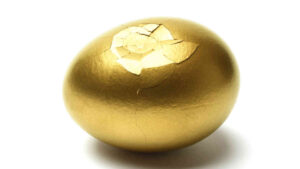Wall Street’s giant cow market could ‘rally before a big collapse’; Gold lacks ‘obvious catalyst’

What we have here is a classic cow market rally. Via Getty
Before Friday’s mini-retreat the Dow Jones Industrial Average closed on Thursday at a peak not since since December.
Next door, the treacherously terrific tech-heavy Nasdaq Composite posted its best finish since April 2022.
The S&P500 is up 15% year to date.
There is sparkle and glitter as US markets have remained closed overnight for the Juneteenth market holiday. That new holiday’s gifted anxious but cashed up US traders an extra day to think about which way they’ll bet after the S&P 500 entered a technical bull market last week.
US investor confidence surged on high-hopes that the US Federal Reserve Bank is surely nearing the end of its historic harassment of low interest-rates.
Unfortunately, Fed officials also struck a more hawkish tone over the weekend in their first bout of Fed-speaking after the central bank held interest rates steady (t’was a mere pause) at its meet last week.
Still, this has given some strength of the US dollar, and in turn applied a little pressure to gold prices which ticked lower in very light trade on Monday.
The path ahead for interest rates remains pretty murky. Which suggests both equities and gold prices could turn on a dime.
Spot gold is just about treading water for now.
The spot did give away just under 0.1% to circa $1,955 by late (Monday) arvo in New York, while US gold futures were down 0.2% to $1,966.98.
That’s more the impact of a rising USD than anything else.
Matt Simpson, senior market analyst at City Index says the precious metal is lacking some clarity and an event to aim for in the mid-to-near-term.
“Gold has spent the majority of June between US$1,935-$1,970, and with no obvious catalyst on the horizon, traders prefer to trade the ranges and not fully commit to a breakout.”
The fearless rally on Wall Street however may be heading toward its own event horizon, according to a note out of the Bank of America on Friday.
Michael Hartnett, the BoA chief investment strategist (he’s they guy who called out the mid-year collapse in shares last June), told clients to expect a similar stock market retreat any day now.
“We are not convinced we (are) at start of brand, new shiny bull market,” BoA said in the Friday note.
“Still feels more like combo of 2000 or 2008, big rally before big collapse.”
The so-called Magnificent 7 mega-cap tech plays – Messrs Apple (APPL), Microsoft (MSFT), Amazon (AMZN), Meta (META)(Facebook), Alphabet (Google), Tesla (TSLA) and now Nvidia (NVDA), the latest to join the US$1trn market cap club), – have been bulldozing the way ahead for US markets and championed the switch from bear to bull over the last months.
Until the US central bank “reintroduces fear” like saying interest rates will need to strike 6% to chase off determined inflation (and until strong US unemployment rises beyond 4% signalling a recession), US stocks can easily stay positive while credit spreads stay muzzled.
In the meantime Hartnett writes, traders are “likely to chase the market higher from momentum to contrarian plays, from deflation to inflation assets, from DM to EM stocks, from no landing plays to hard landing play.”
The ice bucket treatment from the BoA does come after US markets powered on in the first half, and equities seem renewed again and supported strongly to continue that momentum straight into the teeth of macro headwinds like inflation, geoplotics, Chinese trade tensions, rising interest rates and the ever-looming threat of a US recession.
That said, things got pretty brutal for markets last year, falling a foul of Wall Street’s worst year since the 2008 (GFC) financial crisis.
The Dow ended 2022 down 8.8%, the best of all three majors, also snapping a dreamy 3-year winning streak.
The S&P 500 lost over 19% while the tech-heavy Nasdaq Composite plunged more than a full-third of its value.
Related Topics

UNLOCK INSIGHTS
Discover the untold stories of emerging ASX stocks.
Daily news and expert analysis, it's free to subscribe.
By proceeding, you confirm you understand that we handle personal information in accordance with our Privacy Policy.








